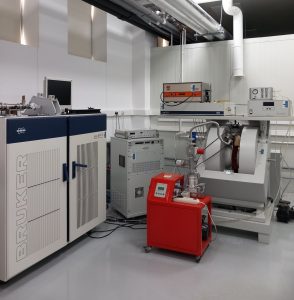Electron Paramagnetic Resonance (EPR)
National Institute of Material Physics in Bucharest
Electron paramagnetic resonance (EPR) or electron spin resonance (ESR) spectroscopy is a technique used to study chemical species with unpaired electrons, called paramagnetic centers. Examples of paramagnetic centers are transition metal ions, free radicals, lattice point defects, radiation induced defects etc. The EPR technique is based on the resonant absorption of microwave photons in a sample submitted to a static magnetic field.
One of the main applications of EPR is the characterization of paramagnetic centers, the determination of their nature, valence, structure, concentration, stability, production and recombination mechanisms. Furthermore, these centers can be used as paramagnetic probes to obtain information about the host material, such as the local structure and symmetry, lattice dynamics, the presence of local strains, the degree of lattice disorder, the mechanism of structural and chemical transformations.

EPR spectroscopy can be used in top research fields, such as the physical phenomena in nanometric particles, characterization of bulk and nanostructured semiconductor and insulating materials, with applications in nanoelectronics and nanophotonics, including quantum computing, characterization of materials for radiation detection and conversion, production of new catalysts, creation of new medicines etc.
Contact: Mariana Stefan
Tel: +40 212418331
Technical specifications and sample requirements
The EPR laboratories are equipped with several EPR spectrometers covering various experimental possibilities and sample requirements. For detailed information please visit the dedicated instruments’ webpages:
ELEXSYS E580 Pulse X-band EPR spectrometer
EMXplus X-band EPR spectrometer
ELEXSYS E500 Q-band EPR spectrometer



